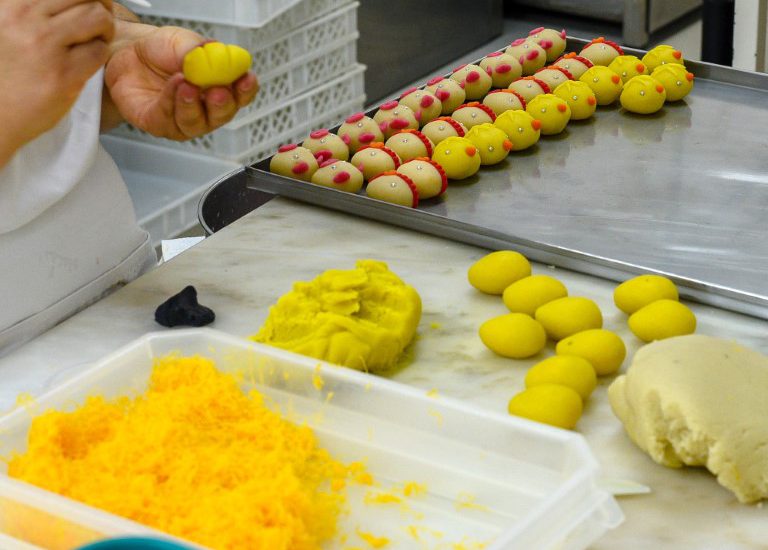- No products in the cart.
Algarvian sweets incorporate the Arabic heritage and the influence of the confectionery created by Portuguese monks and nuns (18th century), adapted to the local ingredients, which, in the Algarve, means mostly sweets made with figs and almonds. This set of ingredients and knowledge “has resulted in a heritage of Algarvian sweets and cakes whose diversity and notoriety are recognised by its excellence” 1!

The Autumn aromas, the figs drying in the sun and the sugar syrups boiling with fennel make us go back to a childhood full of memories and family festivities. Reminders that Mar d’Estórias tries to revive with a trip to the Bolodoce factory in Lagos, where Luísa Silva welcomed us and explained the rituals and the rules of the Algarvian sweet creation.
Luísa mentioned that in 1991, when she started her activity, typical Algarvian sweets were made at home, by confectioners who had learnt the art through observation and practice. These women made doce fino (marzipan cakes) by request, for weddings or for parties, but it was a sporadic production and without any care about the packaging and its presentation: “Household confectioners provided sweets sold by the unit inside shirt boxes.”
 On our trip to the traditional Algarvian confectionery, we had the opportunity to see production tables with “fig cheese”, figs with coconut and almonds bonbons, almonds cakes, morgados and morgadinhos, doce fino (marzipan cakes) cakes and Dom Rodrigos. These are just a few of the many goodies that combine figs, almonds, sugar and eggs.
On our trip to the traditional Algarvian confectionery, we had the opportunity to see production tables with “fig cheese”, figs with coconut and almonds bonbons, almonds cakes, morgados and morgadinhos, doce fino (marzipan cakes) cakes and Dom Rodrigos. These are just a few of the many goodies that combine figs, almonds, sugar and eggs.
We watched a specific funnel slide the egg yolks into the sugar syrup to create the ‘egg threads’, for the doce fino and Dom Rodrigos. As far as we know these are secrets kept and transmitted so that the taste of the Algarve remains untouched, as is the case of the drop of “anise and medronho” that are placed in the “fig cheese”.
 From all this diversity Mar d’Estórias specifically mentions the beautiful sweet miniatures carefully created by the skilled hands of the confectioners – the doce fino cakes. This sugar paste and ground almond, stuffed with ‘egg threads’, is the most identifiable sweet of the region. Formerly the shapes were limited to 30 or 40 varieties of vegetables and animals, but nowadays patisseries are full of doce fino themed cakes to represent Christmas, Easter, Halloween, Valentine’s Day amongst others. Luísa says that “it depends on the ability of each one” in shaping this dough, because not everyone has the skill for this artisanal work. For this reason, the confectioners are hand-picked and have long been part of the factory: “the person in charge works here for 25 years”, says Luísa.
From all this diversity Mar d’Estórias specifically mentions the beautiful sweet miniatures carefully created by the skilled hands of the confectioners – the doce fino cakes. This sugar paste and ground almond, stuffed with ‘egg threads’, is the most identifiable sweet of the region. Formerly the shapes were limited to 30 or 40 varieties of vegetables and animals, but nowadays patisseries are full of doce fino themed cakes to represent Christmas, Easter, Halloween, Valentine’s Day amongst others. Luísa says that “it depends on the ability of each one” in shaping this dough, because not everyone has the skill for this artisanal work. For this reason, the confectioners are hand-picked and have long been part of the factory: “the person in charge works here for 25 years”, says Luísa.
We can say that the marzipan cakes are small works of art, completely handmade, with an intense symbolic load that is lived and savoured with each bite.
 Because of its importance, every year Lagos City Council tries to “contribute to the preservation and revitalization of one of the most genuine and appreciated traditions in the region” 2 through the Feira da Arte Doce. This year the competition was based on the theme Lagos and the Sea – Land of Discoveries, where, amongst others, the marzipan image of Bolodoce was awarded.
Because of its importance, every year Lagos City Council tries to “contribute to the preservation and revitalization of one of the most genuine and appreciated traditions in the region” 2 through the Feira da Arte Doce. This year the competition was based on the theme Lagos and the Sea – Land of Discoveries, where, amongst others, the marzipan image of Bolodoce was awarded.
Like Mar d’Estórias, there are many who work to keep the sweetest gastronomic traditions of the Algarve alive. An effort made so that the traditional sweets, completely made by hand, can continue to represent our identity.
Mediterranean Algarve Tradition, Produce and Cuisine (English Edition) – Cozinhas – VALAGÃO, Maria, CÉLIO, Vasco e GOMES, Bertílio (2015), Lisboa, Tinta da China.
City Hall quote from an interview in the Jornal do Algarve, June 2010.

